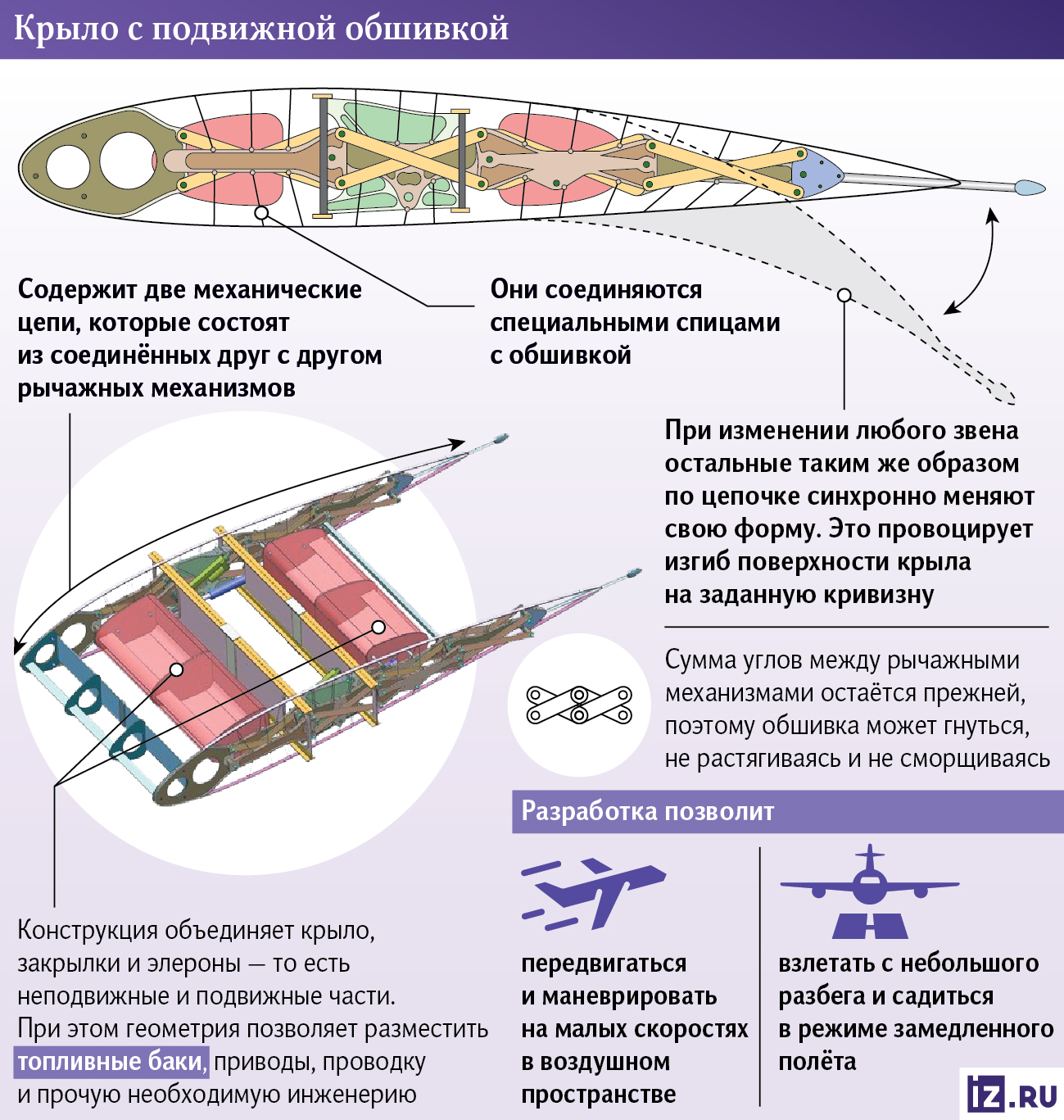Russian design engineers have claimed a groundbreaking advancement in aerospace technology: an innovative wing with a movable skin that promises to create super-maneuverable aircraft.
This innovative design is expected to revolutionize flight dynamics and aircraft performance, according to Izvestia. The key innovation lies in a specialized mechanism that allows the wing’s bearing surface to change shape while maintaining smoothness. This flexibility enables more precise control of flight modes.
Ivan Amelyushkin, head of the Department of Aerophysics of multiphase flows, rarefied gases, and plasma at the Central Aerohydrodynamic Institute, detailed the mechanism: “The wing contains a chain of lever mechanisms connected and linked to the sheathing with special spokes. Altering the geometry of one chain link triggers corresponding changes in the others, creating a smooth curve in the wing surface. The angles between the lever mechanisms remain consistent, allowing the skin to bend without stretching or wrinkling.”
This innovative wing design will facilitate a range of flight maneuvers, enabling aircraft to reduce and increase speed efficiently and perform smooth takeoffs and landings.
“Our design integrates the wing, flaps, and ailerons into a single unit, combining fixed and movable parts. This geometry allows for effective placement of fuel tanks, drives, wiring, and other essential components, resulting in a lightweight, strong, and functional wing,” explained Oleg Druzhinin, a TsAGI (Central AeroHydrodynamic Institute) engineer and co-author of the development.

During the development phase, engineers constructed a full-size model of the wing and a demonstrator of one of its segments. Testing revealed that changing the curvature of the wing profile could alter the angle between the nose and tail segments of the mechanical chain by up to 80°.
One of the major challenges in aerospace engineering has been maintaining the aerodynamic properties of bearing surfaces with variable wing geometry. According to the researchers, this new design effectively addresses that issue.
The proposed wing mechanism allows for better speed control during flight. It also enhances the ability to glide in atmospheric currents at speeds comparable to that of a car.
Aircraft equipped with this mechanism can maneuver gracefully and achieve smooth takeoffs and landings. This revolutionary development in aircraft wing design holds the potential to significantly enhance the performance and versatility of both aerial and underwater vehicles.

Potential Application and Challenges
Despite its apparent simplicity, the wing is one of the most complex elements of any aircraft. It generates the primary lift, determines flight dynamics, and endures the highest loads. So, it is designed for specific operating conditions.
Alexey Rogozin, Director of the Center for the Development of Transport Technologies, said, “The idea of altering the wing for different flight modes could theoretically enhance the aerodynamic characteristics of the airframe significantly.”
The potential demand for this new invention depends on its reliability and safety. Initially, it needs to be tested on unmanned aircraft. If the design and mechanisms prove effective, they can be considered for manned aviation.
According to the developers, these features could be valuable in various aerial tasks, such as spraying fertilizers over fields or conducting search operations.
Another potential application is the creation of safe and cost-effective individual air mobility devices, like hang gliders. The device’s low speed would allow pilots to take off and land safely on their feet.

The versatility of this mechanism extends beyond aviation. The designers believe it could greatly benefit underwater gliders, which adjust their immersion level by altering their density. Movable skin wings would enable these gliders to perform complex underwater maneuvers.
Boris Berkovsky, an aircraft engineering expert and adviser to the director of the Faculty of Engineering at the National University of Mongolia, noted that while the proposed solution was intriguing, it was technically challenging to implement. It requires extensive developments in materials science and microelectronics, as well as comprehensive testing and fine-tuning.
In unmanned aviation, military needs are driving many developments, providing an opportunity for integration into this trend. However, as Oleg Panteleev, Executive Director of the Aviaport Agency, pointed out, many such inventions might be short-lived, only meeting immediate needs.
In manned aviation, proving the consistency and applicability of design solutions can take many years. Nonetheless, experience shows that new developments can be introduced quickly when necessary.
For instance, the Russian expert noted that saber-shaped wingtips designed for the Superjet-100 commercial aircraft five years ago are now part of its main import-substituted version.
- Contact the author at ashishmichel(at)gmail.com
- Follow EurAsian Times on Google News




